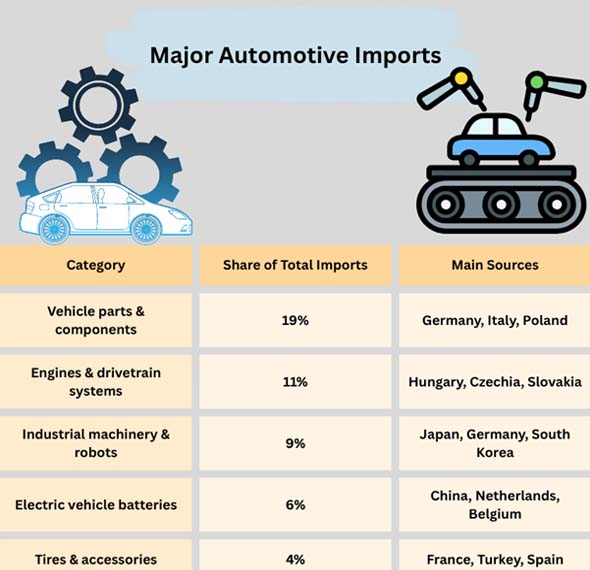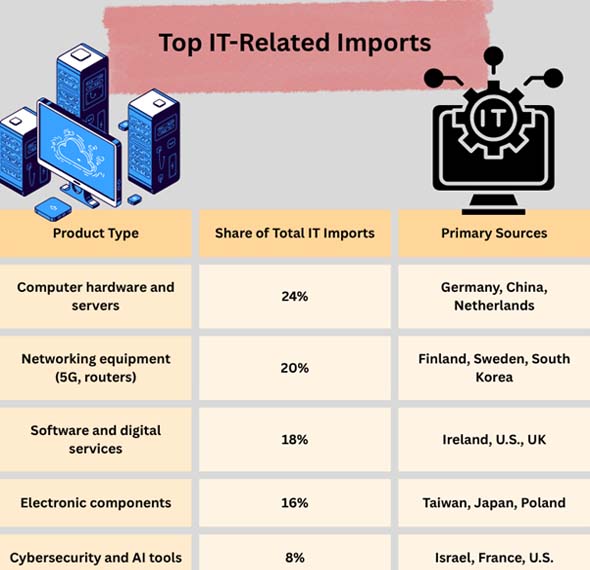
- Nov 10, 2025
Romania's Growing Need for Imports in the It and Car Industries: Alternatives for Trading
As per Romania import data by Import Globals, it is in a fantastic place between Central and Southeastern Europe, which makes it a bridge between EU markets and the Balkans and beyond. A lot has changed in Romania over the past ten years. It used to be a site where products were created, but now it's a busy market with lots of different kinds of businesses. It needs more and more cars and IT goods from other countries to keep its increasing industrial and digital infrastructure up to date.
Romania is buying more industrial and technology-related items as it develops more connected to the European Union's single market. The next sections talk about Romania's import trends, the needs of different sectors, and the new opportunities they present suppliers around the world.
Romania's Trade in Focus
Romania's economy is open and focused on exports, but imports are just as crucial for keeping its factories functioning. The country bought more than $125 billion worth of goods in 2024. This amount goes up every year because people buy more and invest more.
The auto industry is Helping other Industries Grow
As per Romania Export Data by Import Globals, the car sector makes for over 14% of Romania's GDP and employs more than 200,000 people. Dacia (part of the Renault Group) and Ford Otosan Craiova are two Romanian enterprises that have helped Romania become a competitive automotive hub in Eastern Europe.
But this success depends a lot on receiving parts, tools, and high-tech electronics from other countries that are needed for assembly and new ideas.
As Romania pushes toward electric cars (EVs) and automation, the automotive supply chain is transforming. As per Romania Import Export Trade Data by Import Globals, the government is giving businesses reasons to develop and sell electric cars. This means that the need for battery technology, EV parts, and robots will increase up a lot in the next five years.

Need for Tech and IT Imports
As per Romania Export Data by Import Globals, Romania has swiftly become a key hub for outsourcing and technology in Eastern Europe. The country has more than 190,000 IT workers, and its digital economy is closely linked to the EU's. The government has bought more IT from other countries to help with software development, hardware infrastructure, and cybersecurity solutions.

The main reasons for importing IT Are
Data centers and cloud computing: As per Romania Importer Data by Import Globals, Multinational corporations are helping Romania's data environment grow by bringing in servers, networking devices, and security solutions. Romania's businesses and government are turning digital via buying software, digital platforms, and business solutions.
As construction on the 5G infrastructure progresses, more routers, fiber-optic cables, and base station equipment are arriving into the country. As per Romania Import Trade Statistics by Import Globals, Romania's electronics and IT hardware assembly industries need to keep getting semiconductors and other electronic parts from Asia and Western Europe.
Putting money into the Climate and Helping Trade
Romania's economy is still performing well since it is in the EU, has low labor costs, and a well-developed transportation system. Because it is close to the Black Sea and has adequate road and rail networks, the country can readily trade with other European and Asian countries.
Here are some good reasons to encourage imports and the growth of industry:
Money-giving EU Programs: There is a lot of money available to restore and rebuild infrastructure for IT, transportation, and renewable energy.
Tax Advantages for Bringing in Technology: cheaper tariffs on equipment for digital and renewable energy.
As per Romania Import Shipment Data by Import Globals, Free Economic Zones are places that let importers pass through customs faster and pay less in taxes. Romania's commercial sector is growing quickly because the government is still helping the country move to digital and renewable energy.
New Ways to Make Cash
As per Romania Import Export Trade Analysis by Import Globals, Romania's car and IT industries are both developing, which allows investors and exporters from all over the world a multitude of possibilities to get in:
Parts for Electric Cars: As more assembly plants operate in the US, they always need batteries, sensors, and charging systems to be shipped to them. As per Romania Import Trade Analysis by Import Globals, Getting new machines from Europe and Asia is helping factories move up to Industry 4.0 norms.
Digital Infrastructure: As data centers and telecom firms grow, they need to buy additional fiber-optic and server equipment.
Smart Mobility and Connectivity: Companies that make software, processors, and navigation systems for connected cars may be able to do business.
As per Romania Export Import Global Trade Data by Import Globals, Romania's expanding local consumption and integration into European value chains will keep demand for high-tech imports strong for a long time.
Issues with Growth Caused by Imports
Romania's policies and structures are suffering a lot of challenges, but the future seems good:
Here are some of the risks of having a Trade Deficit: The trade imbalance gets bigger when imports keep growing faster than exports.
Dependence on the Supply Chain: If you rely too much on high-tech goods from other countries, you are more likely to have issues all over the world.
Energy Costs: Changes in the prices of gas and electricity still have an effect on businesses.
Not Enough Skills: Technology is evolving so quickly that those who work in IT and modern business can't keep up with their training. The EU is working to tackle these problems by making education better, strengthening infrastructure, and encouraging people to utilize energy in ways that don't hurt the environment.
As per Romania Import Data by Import Globals, Romania's imports will keep rising rise in the future (2025–2030) as the country modernizes its economy and goes digital faster. From 2025 to 2030, the number of cars exported into the country is expected to rise by 8–10% per year, largely in the EV and parts sectors.
The growth of AI, cloud computing, and 5G might lead to a 12 to 15 percent increase in IT-related imports each year. Asian and North American enterprises will work together more, which will make commerce more interesting. Romania is one of the best countries to do business in Eastern Europe since its industries are so strong. It has a good balance of power in industry and room for fresh ideas.
To sum up,
Romania's growing need for imports in the automotive and IT sectors illustrates how swiftly the country is modernizing to become more modern and a leader in technology in the EU. International companies want to do business here because the location is wonderful, the people is skilled, and the infrastructure is getting better. Romania's import environment will still be an excellent place to conduct business, even if electric cars, automation, and digital transformation disrupt the industry. This will link the old-fashioned manufacturing business to the new economy of the future. Import Globals is a leading data provider of Romania Import Export Trade Data.
FAQs
Que. What are the most essential things that Romania gets from other places?
Ans. Computers, electronics, car parts, and machineries are among of Romania's most important imports.
Que. What countries send Romania the most important things?
Ans. Germany, Italy, Hungary, Poland, and China are the key countries that do business with each other.
Que. Why does Romania need to get more IT products from other countries?
Ans. The digital world, 5G, and the sector of software development are all growing very quickly.
Que. What kinds of trade agreements can exporters from other nations make?
Ans. You can make a lot of money by selling parts for electric cars, digital infrastructure, industrial automation, and cybersecurity technology.
Que. Where can you obtain detailed Romania Import Export Global Data?
Ans. Visit www.importglobals.com or email info@importglobals.com for more information on up-to-date data.
